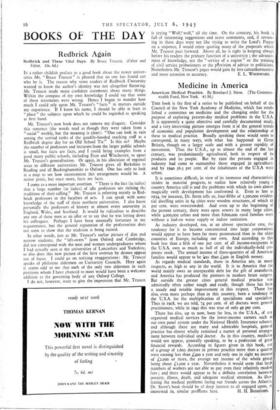Medicine in America
This book is the first of a series to be published on behalf of the Council of the New York Academy of Medicine, which has estab-
lished a committee on medicine and the changing order for the purpose of exploring present-day medical problems in the U.S.A. It is -apparently a quite objective and carefully documented study, and a very interesting picture emerges from it of the general trends of economic and population development and the relationship of these to medical practice. Broadly speaking these would seem to correspond, in many ways, with what has happened in Great Britain, though on a larger scale and with a greater rapidity of movement. Thus the U.S.A., up to almost the end of the last
century, was predominantly agricultural, both in respect of its products and its people. But by 192o the- persons engaged in industry had come to outnumber those engaged in agriculture; and by r94o 56.5 per cent. of the inhabitants of the U.S.A were urban.
It is sometimes difficult, in view of its immense and characteristic strides in material progress, to realize how relatively young a country America still is and the problems with which its own almost magically swift development has confronted it. Even as late as 1934, for instance, Dr. Stern tells us, four-fifths of I,5oo,000 residen- tial dwelling units in 64 cities were wooden structures, of which 16 per cent. were overcrowded. And even up to the beginning of the present century, there were open sewers in many large cities. while 4,000,000 urban and more than 8,600,000 rural families were without a laid-on water supply or indoor sanitation.
As industry developed, too, at an almost spectacular rate, the tendency for it to become concentrated into large corporations would appear to have been far more pronounced than in the older countries of Europe, including our own. And according to this book less than a fifth of one per cent. of all income-recipients in the U.S.A. own as much as half of all the individually-held cor- porate stock. The annual income of three-quarters of all American families would appear to be less than £400 in English money.
As regards medical standards, those in America are, in many respects, as high as any in the world. It is to America that the world mainly owes an unrepayable debt for the gift of anesthesia, and America has produced the pioneers in modern brain surgery. But outside the greater cities general medical practice was admittedly often rather rough and ready, though there has been a steady and notable improvement in this respect. There has also, even more perhaps _than in this country, been a tendency in the U.S.A. for the multiplication of specialisms and specialists. Thus in 1928, we are told, 74 per cent. of all doctors were general practitioners, while in 1942 this was true of only 49 per cent.
There has also, up to now, been far less, in the U.S.A., GT any organised medical services for the lower-income earners such as our own panel system under the National Health Insurance scheme; and although there are many and admirable hospitals, general practice has almost wholly remained a matter of personal arrange- ment between individual and doctor. As in this country, medicine would not appear, generally speaking, to be a profession of great financial rewards. According to figures given in this book, out of a group of x,600 doctors in private practice more than a quarts were earning less than £400 a year and only one in eight an income of £2,000 or more, the average net income of the whole group being about £t,000 a year. Nevertheless it would seem that large numbers of workers are not able to pay even their relatively modest fees ; and there would appear to be a definite correlation between poverty, illness, death, and adequate medical attention. As illus- trating the medical problems facing our friends across the Atlantic, Dr. Stern's book should be of deep interest to all engaged upon, af interested in, similar problems here. H. H. BAsHroan.




























 Previous page
Previous page